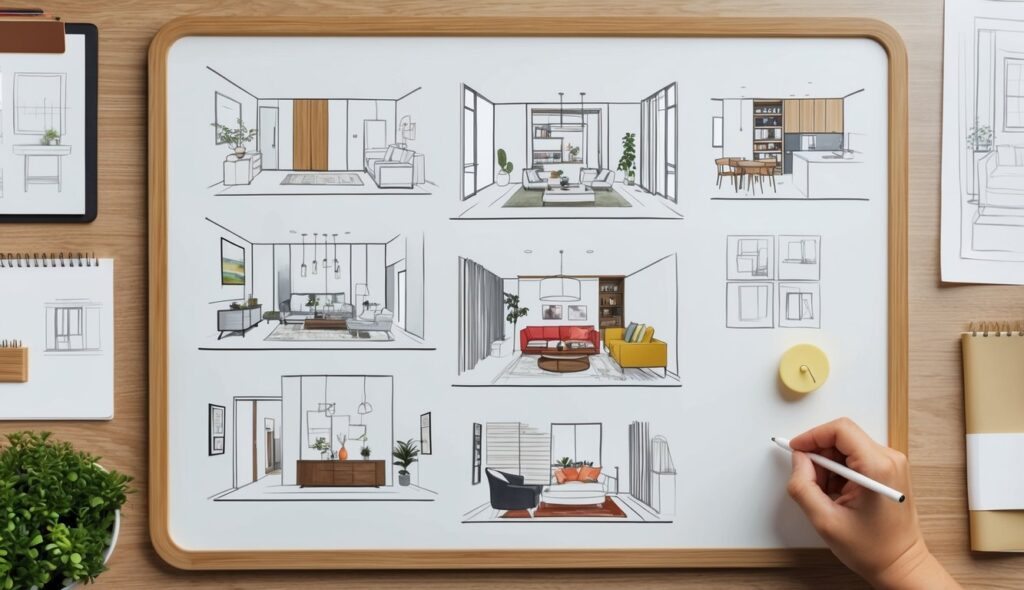The choice of paint colors in architectural spaces goes beyond mere decoration. Colors can profoundly influence the perception and behavior of individuals within a space, making them a critical element in architectural design.
Remember to repin your favorite images!
For instance, red is often used in commercial environments like fast food outlets to evoke energy and excitement. It stimulates impulsivity and consumer behavior (https://www.archdaily.com/895498/the-role-of-color-in-architecture-visual-effects-and-psychological-stimuli).
Green, on the other hand, offers a soothing and relaxing ambiance, making it suitable for spaces meant for rest and rejuvenation (https://www.archdaily.com/930266/how-color-affects-architecture).
Lighter colors, such as pastels, tend to make spaces appear larger and more open. This can be particularly useful in compact urban areas or smaller rooms (https://www.archdaily.com/935067/how-colors-change-the-perception-of-interior-spaces).
Conversely, darker shades create a sense of intimacy and coziness, making large spaces feel more welcoming. The strategic use of these colors can thus significantly affect both the aesthetics and functionality of a space.
From guiding the viewer’s eye to impacting emotional well-being, color is an essential component of design that architects must skillfully navigate. Utilizing the principles of color psychology can lead to more thoughtful and effective architectural solutions.
Understanding Color Psychology in Architecture
The use of color in architecture significantly affects the perception and function of spaces. It influences mood, behavior, and the ambiance of a room.
The Role of Color in Shaping Architectural Spaces
Color plays a key role in architectural design. Architects select colors to define the purpose and atmosphere of a space.
Red, for example, can evoke energy and excitement which is why it’s often used in commercial spaces like fast food restaurants.
Blue, on the other hand, can create a calming effect, making it ideal for offices or healthcare settings. Meanwhile, green is often used in educational facilities due to its balancing and nurturing qualities. These choices are informed by color psychology and the understanding of how colors affect human emotions and behavior.
Color, Light and Perception
Lighting greatly influences the perception of color in architectural spaces. Natural light can enhance the vibrancy and clarity of colors.
For example, a yellow wall under sunlight appears brighter and more vivid.
Artificial light, such as LED and fluorescent lights, can alter the way colors are perceived.
Warm lights may intensify warm colors like red and orange, while cool lights enhance colors like blue and green. This interplay between color and light is crucial for interior designers when planning the ambiance of a room.
Influence of Color on Mood and Emotions
Colors have a profound impact on mood and emotions.
Warm colors like red, yellow, and orange can stimulate and energize individuals. These colors are often used in areas intended for social interaction and activity.
Cool colors, such as blue and green, tend to have a calming and soothing effect. They are typically employed in bedrooms or therapeutic environments to foster relaxation. Meanwhile, neutral colors like beige and gray can create a modern and sophisticated feel, promoting focus and tranquility. Architects use these principles of color theory to design spaces that support the well-being and productivity of occupants.
From Concept to Application: Color Strategies in Design
Architects use color in design to influence mood, evoke emotions, and enhance the aesthetic quality of spaces.
Strategic use of color can transform a building’s atmosphere, make a space more inviting, or convey particular psychological effects.
Analyzing Architectural Styles and Color Usage
Different architectural styles utilize color in unique ways. For example, modernist architects like Le Corbusier often used primary colors to create a sense of purity and straightforwardness.
In contrast, Luis Barragán incorporated bright, saturated hues to evoke emotional responses and link indoor spaces to the natural landscape. Understanding these stylistic applications is crucial in creating cohesive designs that respect historical and stylistic contexts.
Each style dictates specific color palettes, contrasts, and saturations that can reinforce the desired aesthetic and emotional impact.
Designing for Human Experience: Color in Environmental Psychology
Color greatly affects human behavior and emotions.
In healthcare facilities, soft, pastel tones are frequently used to create calming environments. In educational settings, brighter colors can stimulate energy and focus.
Psychologists have found that colors can alter emotional reactions and even impact behaviors.
For instance, blue is often associated with tranquility and productivity, while red can incite excitement or urgency. Architects must consider these psychological impacts when selecting color schemes to design environments that promote well-being and functionality.
Implementing Color Theory in Modern Spaces
Modern color theory revolves around concepts like the color wheel, complementary colors, and contrast to create visually appealing and functional spaces.
Complementary colors can make areas pop, while analogous colors create harmony.
For contemporary projects, architects might explore innovative color applications. They may use bold accent walls or integrate color with light to define spaces.
Simple tools like the Samplize paint samples can aid in visualizing these color choices in real life.
By thoroughly understanding and applying color theory, architects can craft spaces that are both aesthetically pleasing and psychologically beneficial.

